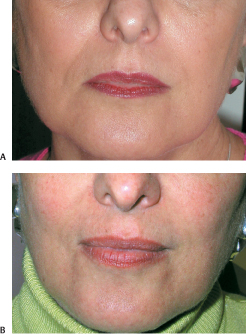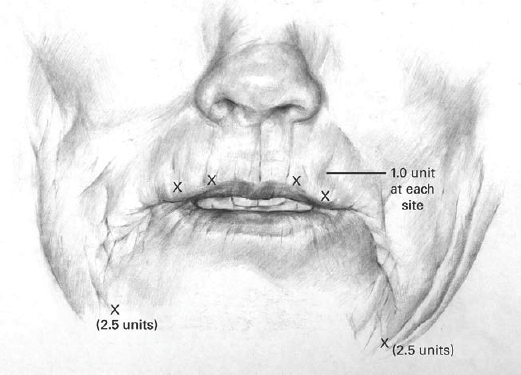14
Defining the Principles of Perioral Rejuvenation
Rejuvenation of the perioral area is inadequately addressed with soft tissue facial surgical procedures. Restoration of the internal architecture and compensation for the loss that results from diminishing of the midfacial bone volume and dental support is a prerequisite for rejuvenation of the perioral contours and the lips. These changes are not always age related. They can be enhanced and fine-tuned with neuromodulation and soft tissue filling. Lip volume can be enhanced with filling agents and faded pigment restored with micropigmentation.
 Approach to Perioral Rejuvenation
Approach to Perioral Rejuvenation
We use a five-step approach to perioral rejuvenation:
- Intraoral compensation for midfacial bone volume loss
- Establishment of dental support
- Neuromodulation plus soft tissue filling
- Laser resurfacing of the upper lip skin (when indicated)
- Augmentation and micropigmentation of the lips
Steps 1 and 2 are discussed in Chapters 15 and 16, respectively. Steps 3 through 5 are discussed below.
Neuromodation Plus Soft Tissue Filling
After the reestablishment of the midfacial volume and dental contours, the perioral soft tissue can be addressed. In the perioral area, Botox neuromodulation sets the stage and prolongs the results of effective filling and recontouring of the soft tissues. Placement of the injection sites and dosages must be precise to avoid imbalance of mouth movements. Two units to each depressor anguli oris muscle at the mandibular angle will subtly elevate the corners of the mouth and soften the oral commissures,1–3 (Fig. 14-1A,B) facilitating filling. Perlane (Q-Med, Uppsala, Sweden), more viscous than Restylane (Medicis, Scottsdale, Arizona), effectively fills the oral commissures and can further support the angles of the mouth4 (Figs. 14-2; 14-3A,B). When loss of skin tone and resilience is apparent, results can be further enhanced with skin tightening and collagen-stimulating procedures using Thermage (Thermage, Hayward, California), nonablative lasers, and intense pulsed light (IPL) (Fig. 14-4A,B).

Figure 14-1 (A) Before and (B) after 2.5 units of Botox were given to each depressor anguli oris muscle to elevate the corners of the mouth.

Figure 14-2 Neuromodulation of the depressor anguli oris muscles can augment the use of filling agents to improve oral commissures contours. Cautious neuromodulation of the orbicularis oris muscle can augment the use of filling agents to improve upper lip rhytidosis and contour deficiencies.
Stay updated, free articles. Join our Telegram channel

Full access? Get Clinical Tree



